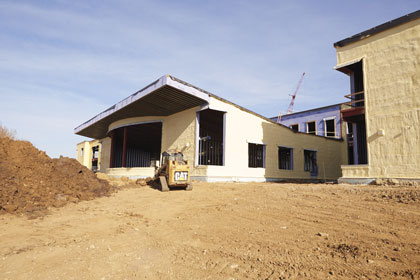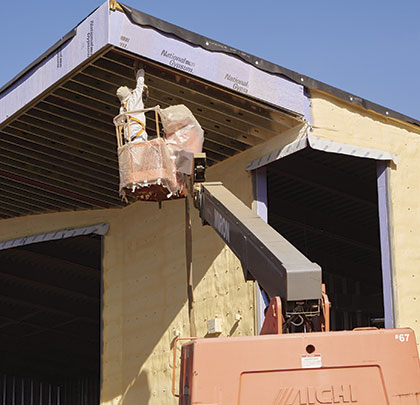When the Prescott School District in Wisconsin started planning for a new high school, its main concern involved solving space constraints in existing buildings and preparing for increased enrollments and community use opportunities. Its new 140,000-square-foot building will address those concerns when it opens for the start of the next school year, but it will also be operating efficiently thanks to an innovative use of spray polyurethane foam (SPF) insulation.
To create a tight and effective building envelope—one well suited for housing the new building’s classrooms, cafeteria, auditorium, and gymnasium for decades to come—the school district selected SPF. The District selected SPF as a wall insulation to help meet some of the highest climate control standards, while reducing heating and cooling costs.
But beyond SPF’s use as an interior insulation product, everyone involved in the $28 million construction project—the architect, the school district leadership, and the insulation contractor—saw the opportunity to increase the insulation benefits by adding it to the exterior, resulting in enhanced energy efficiency. And, energy efficiency was not the only additional benefit. The school district also reduced installation expenses, labor costs, and waste by eliminating the need for multiple insulation materials.
GREAT INSULATION FOR MASS WALLS
Prescott High School is built with mass walls, a common construction method for schools that use concrete blocks or slabs as the main structural components. While these mass walls are known for sturdiness and durability, they can be prone to moisture intrusion and air infiltration that may reduce their effectiveness in controlling the internal environment and compromise their durability. By applying closed-cell spray polyurethane foam (ccSPF) on the exterior, the building is well positioned to meet expectations for energy efficiency, while maintaining durability.
“Prescott High School benefited from using spray foam as an exterior insulation due to the monolithic seal,” says Phil Bulfer, owner of Greener World Solutions, the contractor that installed the insulation at the new school. “Conventionally, these mass walls are sheeted with board stock, which has cracks and gaps between the boards, not creating a monolithic seal.”
Bulfer explains that for this building, there were 28 sets of ccSPF on the exterior, with each two 55-gallon drum set (each drum containing one of the component chemicals mixed onsite to create the insulation) covering approximately 4,750 board feet (1 square foot x 1 inch). Greener World Solutions applied 1 inch of foam on the gypsum sheeting and 2 inches on the concrete block. On the interior, the company used 22 sets on the section of the building with gypsum walls, applying 3 inches between the steel studs.
While SPF has been a popular insulation choice for several years, according to Bulfer, Greener World Solutions has only used SPF twice in this innovative way—on the entire exterior of a mass wall building. But this method clearly offers enormous benefits, as the new Prescott High School gets a high R-Value (approximated at an R-7 per inch) insulation, moisture protection, and vapor control and air barrier protection all in a single product.

Featured Image: A trained closed-cell spray polyurethane foam insulation installer sprays the insulation under the eaves of the new Prescott High School.
Above: A layer of closed-cell spray polyurethane foam insulation has been added to the exterior of the concrete block mass wall structure of the new Prescott High School.
Photos courtesy of Icynene/Curtis Johnson (photographer)
SPF is able to effectively provide such benefits because it is continuously applied to the structural concrete or masonry block wall, reducing opportunity for air and moisture gaps. Once SPF is installed, the exterior walls are covered by a finish, which for Prescott High was a brick veneer.
“Spray foam made the most sense for Prescott High School because spray foam is a great performing system for continuous insulation with a brick exterior veneer,” says Cory Tamm, Midwest regional sales manager for Icynene, the manufacturer of the ccSPF used in this project. “The high R-value, which is one of the highest in the market, applying 3 inches in one pass, which saves on labor costs, and the support for control joints, slashing, expansion joints, and details around extrusion all made closed-cell spray foam a great product for the job.”
The facility’s finished walls will work well for keeping the school’s more than 400 students and staff comfortable during Wisconsin’s cold winters and hot summers. In addition to improving efficiency, the SPF insulation offers design flexibility, prevents thermal bridging, and shifts the dew point in walls to help avoid condensation and other moisture issues.
WHY CLOSED-CELL MATTERS
While there are multiple types of SPF insulation, ccSPF is used for exterior applications to form a continuous layer of insulation.
The difference in the types of SPF insulation is due to the method used to create the cells or pockets of air or gas that give SPF its excellent insulation qualities. Open-cell SPF insulation uses water as the blowing agent. The water quickly reacts with the other chemicals to produce CO2, which then expands the polymer cells. Once expanded, the CO2 leaves the cells and is replaced by air, creating a layer of semi-rigid foam. Closed-cell SPF insulation instead uses a chemical blowing agent, which is retained inside the polymer cells after the foam is formed, creating a rigid, dense foam. Rigid closed-cell SPF provides an air barrier, limits moisture ingress, and can add structural integrity to a building’s exterior.
AN ECONOMICAL INVESTMENT
This insulation provides cost benefits by lowering heating and cooling bills over time, and serving as a moisture and air barrier, which can eliminate the need to install separate air or moisture management systems. This equates to lower initial costs, as additional layers and steps needed to provide that protection can be either skipped or decreased. This sealing ability matters because the U.S. Department of Energy reports that up to 40 percent of building energy is lost due to uncontrolled air leakage. Because of this barrier, the Prescott School District will be able to better control energy costs.
“Because it’s economical, using spray foam is gaining traction,” explains Bulfer. “Spray foam will give Prescott High School tremendous savings on installation and other cost benefits over time.”
As a result of the SPF products used in the construction of Prescott High School, its students and teachers will enjoy a comfortable new learning environment regardless of the season. And, the school district can be confident of the building’s resistance to water and air permeation, that utility costs will be lowered, and the new building will be a crown jewel among the district’s facilities for years to come. ■
About The Author: Anthony Naimoa is the marketing communications and public relations manager with Icynene. For more information, visit www.icynene.com.
_________________________________________________________________________
Modern Contractor Solutions – December 2016
Did you enjoy this article?
Subscribe to the FREE Digital Edition of Modern Contractor Solutions magazine.

School Finds Success with a Spray Polyurethane Foam Insulation


